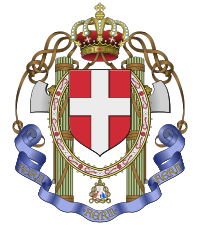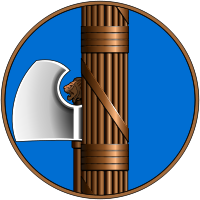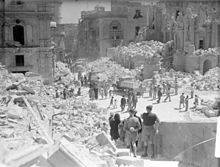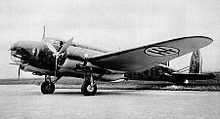- Regia Aeronautica
-
The Italian Royal Air Force (Regia Aeronautica Italiana) was the name of the air force of the Kingdom of Italy. It was established as a service independent of the Royal Italian Army from 1923 until 1946. In 1946, the monarchy was abolished and the Kingdom of Italy became the Italian Republic, whereupon the name of the air force changed to Aeronautica Militare Italiana.
History
At the beginning of the twentieth century, Italy was at the forefront of aerial warfare: during the colonization of Libya in 1911, it made the first reconnaissance flight in history on 23 October, and the first ever bombing raid on 1 November.
During World War I, the Italian Corpo Aeronautico Militare, then still part of the Regio Esercito (Royal Army), operated a mix of French fighters and locally-built bombers, notably the gigantic Caproni aircraft. The Regia Marina (Royal Navy) had its own air arm, operating locally-built flying boats.
The Italian air force became an independent service—the Regia Aeronautica—on March 28, 1923. Benito Mussolini's fascist regime turned it into an impressive propaganda machine, with its aircraft, featuring the Italian flag colors across the full span of the undersides of the wings, making numerous record-breaking flights. It reached its zenith when two squadrons of flying boats, led by General Italo Balbo, crossed the Atlantic Ocean in 1931 and 1933 respectively. During the latter half of the 1930s, the Regia Aeronautica participated in the Spanish Civil War, as well as the invasion of Ethiopia.
Ethiopian War
During the Ethiopian war, the Regia Aeronautica performed massive poison gas bombings and sprayings over the Ethiopian country side using mustard gas and phosgene. Despite being inadequately equipped, the Regia Aeronautica managed to decimate Ethiopian forces and undertook massive bombings of Ethiopian cities (particularly Addis Abeba). The operations of the Regia Aeronautica were crucial for the success of the invasion of the Regio Esercito and was enhanced by the near total lack of an opposing Imperial Ethiopian Air Force.
Spanish Civil War
During the Spanish Civil War Italian pilots fought alongside Spanish Nationalist and German Luftwaffe pilots as members of the "Aviation Legion". This deployment took place from July 1936 to March 1939 and complimented an expeditionary force of Italian ground troops titled "Corps of Volunteer Troops". In Spain, the Italian pilots were under direct command of the Spanish Nationalists and took part in training and joint operations with the pilots of the German "Condor Legion".
Albania
The Regia Aeronautica played a limited role during the Italian invasion of Albania.
World War II
When World War II began in 1939, Italy had the smallest air force among the three major Axis powers. With a paper strength of 3,296 machines, only 2,000 were fit for operations, of which just 166 were modern fighters. The Macchi MC.200 and Fiat G.50 were the best available but were still slower than potential Allied fighters. While numerically still a force to be reckoned with, it was hampered by the local aircraft industry which was using obsolete production methods. Technical assistance provided by its German ally did little to improve the situation.
Battle of France
In June 1940, during the closing days of the Battle of France, Italy declared war on France and the United Kingdom. The Regia Aeronautica carried out 716 bombing missions in support of the invasion of France by the Regio Esercito. Italian aircraft dropped a total of 276 tons of bombs.
Middle East
Regia Aeronautica aircraft were involved in the Middle East almost from the start of Italian involvement in World War II. During the Anglo-Iraqi War, German and Italian aircraft of "Flyer Command Iraq" (Fliegerführer Irak) stopped to refuel in the Vichy French-controlled Mandate of Syria as they flew to Iraq. These masqueraded as Iraqi aircraft and were painted as such en route. Continued concern over German and Italian influence in the area led to the Allies' Syria-Lebanon Campaign.
 Destruction of Muslim graveyard and the Istiklal Mosque by Italian bombers during the bombing of Haifa, September 1940.
Destruction of Muslim graveyard and the Istiklal Mosque by Italian bombers during the bombing of Haifa, September 1940.
In one of the lesser known incidents of the war, starting in July 1940, Italian aircraft bombed cities in the British Mandate of Palestine. In mid-October, the Italians also bombed American-operated oil refineries in the British Protectorate of Bahrain.[1]
East Africa
ln June 1940, the Regia Aeronautica in Italian East Africa had between 200 and 300 combat ready aircraft. Some of these aircraft were outdated, but the Italians had Savoia-Marchetti SM.79 and Savoia-Marchetti SM.81 bombers and Fiat CR-42 fighters. In relative terms, these were some of the best aircraft on hand to either side at the beginning of the East African Campaign. In addition, the Italian aircraft were often based at better airfields than those of the British and Commonwealth forces. When the war began, Italian pilots were relatively well trained and confident of their abilities. Cut off from Italy as they were though, problems with lack of fuel, munitions, spare parts and replacements became a serious problem and the Regia Aeronautica was worn down in a war of attrition. By 31 January, Prince Amedeo, Duke of Aosta, reported that the Italian military forces in East Africa were down to 67 operational aircraft with limited fuel and on 24 October 1941, about one month prior to the final Italian surrender, the last Italian aircraft of the campaign was shot down.[2]
Battle of Britain
From 25 October 1940, some 170 Italian planes (including 73 Fiat Br.20 bombers) were sent to occupied Belgium to form the Italian Air Corps (Corpo Aereo Italiano, or CAI) to participate in the Battle of Britain. The CAI achieved only very limited successes and in December 1940, were largely withdrawn to Greece.[3] The last Italian aircraft left Belgium by mid-April 1941.
Western Desert
Initially, the Western Desert Campaign was a near equal struggle between the Regia Aeronautica and the British Royal Air Force (RAF). Early on, the fighters available to both sides were primarily older biplanes with Italian Fiat CR.32 and Fiat CR.42s flying against British Gloster Gladiators. Later, the balance of power would shift periodically as each side obtained improved aircraft.
After the Italian disasters during Operation Compass and the arrival of General Erwin Rommel and his German Africa Corps, the Regia Aeronautica in the Western Desert became dependent on the German Luftwaffe.
Although the air campaign in Libya was seriously limited because of desert conditions, the Italian Royal Air Force managed to retain a force of nearly four hundred airplanes. During the first British counter-offensive, the Regia Aeronautica had suffered heavy losses (over 400 aircraft) until the Axis attack on Greece began, when a major part of the British land and air forces were diverted there giving the Italian forces time to recover. New Italian aircraft and units were supplemented by the arrival of the German Afrika Corps, and the attached Luftwaffe contingent deployed almost 200 airplanes in Libya and another 600 in Sicily. Working with the Luftwaffe, the Regia Aeronautica performed better due to the exchange of tactical doctrine and the arrival of more modern aircraft. During Rommel's first offensive, the Italians managed to divert RAF attacks from Rommel's forcesand covered Rommel's retreat during the British Operation Crusader while inflicting heavy losses on RAF bombers.
During Rommel's second offensive the Regia Aeronautica and the Luftwaffe suffered considerable losses due to stronger Allied resistance during the air battles over El Alamein and the bombing raids over Alexandria and Cairo. The Regia Aeronautica, having suffered heavy losses in Egypt, was withdrawn progressively to Tobruk, Benghazi, Tripoli and, eventually, Tunisia.
Malta
The Regia Aeronautica participated in the air offensive on the British controlled island of Malta along with the German Air Force in an attempt to gain control of the Axis sea routes from Sicily, Sardinia, and Italy to North Africa. Although on the edge of starvation and suffering heavy losses, Malta managed to withstand the attacks from the Italian and German air forces, and inflicted losses of almost 1,500 planes.
The battle cost the RAF 800 planes and considerable numbers of transport ships, but the cost to the Axis was far higher, with 60% of Axis supplies sent to Africa sunk thanks to British aircraft, submarines, and destroyers based in Malta, cutting the Axis forces in Africa off from resupply efforts.
Gibraltar
Mainly in 1942, Piaggio P.108 Italian bombers attacked Gibraltar several times from Sardinia. The most spectacular raids with the bomber P. 108 were flown in October 1942 when several night attacks against Gibraltar were undertaken from Sardinia.[4] The last raids on Gibraltar were done during the 1943 Allied landing in Algeria, when those bombers even managed to hit the port of Oran successfully.
The only unit of the Regia Aeronautica to fly the Piaggio P.108 was the "274th Long-Range Bombardment Group" which was formed in May 1941 as the first machines came off the assembly lines. Training and acheiving full operation strenghth took far longer than anticipated and the 274th only became operational in June 1942.
Greece and Yugoslavia
In late 1940, the Regia Aeronautica enjoyed complete air superiority during the Greco-Italian War. However, this did not stop the Royal Hellenic Army from forcing the Regio Esercito onto the defensive and back into Albania. In early 1941, the tide was turned as the German Wehrmacht launched its invasion of Yugoslavia. From that point on, the role of the Regia Aeronautica in the Balkans Campaign was primarily that of support to the Luftwaffe. This support role continued during the occupation of Greece and the occupation of Yugoslavia that followed.
Eastern Front
In August 1941 the Regia Aeronautica sent an Air Corps of 1,900 personnel to the Eastern Front as an attachment to the "Italian Expeditionary Corps in Russia" (Corpo di Spedizione Italiano in Russia, or CSIR) and then the "Italian Army in Russia" (Armata Italiana in Russia, or ARMIR) were known as the "Italian Air Force Expeditionary Corps in Russia" (Corpo Aereo Spedizione in Russia). These squadrons, initially consisting of 22° Gruppo CT with 51 Macchi C.200 fighters and 61° Gruppo with the Caproni Ca 31 bomber, supported the Italian armed forces from 1941 to 1943. They were initially based in the Ukraine and ultimately supported operations in the Stalingrad area. In mid 1942 the more modern Macchi C. 202 was introduced to operations in Russia. The CSIR was subsumed by the ARMIR in 1942 and the ARMIR was disbanded in early 1943 after disaster during the Battle of Stalingrad. The Air Corps pulled out of operations in January 1943, transferring to Odessa.
From 1944 to 1945, Italian personnel operated from the Baltic area and in the northern part of the Eastern Front under the direct command of the Luftwaffe under the name Air Transport Group 1 (Italian: 1° Gruppo Aerotrasporti "Terracciano" , German: 1° Staffel Transportfliegergruppe 10 (Ital)). This group was part of the National Republican Air Force of the Italian Social Republic.
Tunisian Campaign
By the time of the Tunisian Campaign, the Regia Aeronautica and the Luftwaffe rarely enjoyed parity let alone air superiority in North Africa.
Sicilian Campaign and before 8 September 1943
The Regia Aeronautica was put in a defensive role during the Sicilian Campaign. Italian pilots were constantly fighting against Allied efforts to sink Regia Marina ships. Just before the Allied invasion, a huge Allied bomber offensive struck the airfields in Sicily in an effort to gain further air superiority. This left the Regia Aeronautica very weak, but still alive as aircraft continued to arrive from Sardinia, southern Italy, and southern France. The last mission of the Regia Aeronautica before the truce with the allies was the defence during the (USAAF) bombing on Frascati—Rome on September 8, 1943.
Post-armistice
After the Italian armistice, the Regia Aeronautica was briefly followed by two new Italian air forces. In southern Italy, the Royalist Italian Co-Belligerent Air Force (Aviazione Cobelligerante Italiana, or ACI) fought alongside the Allied forces. In northern Italy, the National Republican Air Force (Aeronautica Nazionale Repubblicana, or ANR) flew for the Italian Social Republic and the Axis. The first ANR fighter unit was the 101st Gruppo Autonomo Caccia Terrestre, based in Florence.
Aircraft of the Royal and Republican air forces never fought each other. The ACI operated in the Balkans and the ANR operated in northern Italy and the area around the Baltic Sea.
Losses suffered during the conflict consisted of 3,007 dead or missing, 2,731 wounded and 9,873 prisoners of war. Some 5,201 aircraft were lost, while Italian fighter pilots claimed 4,293 aircraft destroyed, including 1,771 destroyed on the ground.[5]
Regia Aeronautica Aces (World War II)
The Regia Aeronautica tended not to keep statistics on the individual level, instead reporting kills for a certain unit, attributed to their unit commander. However, pilots were able to keep personal log books, so the few that survived through World War II give individual statistics. Here is a list of the aces attributed with ten or more kills.
- Franco Lucchini - 26 kills
- Adriano Visconti - 26 kills
- Teresio Martinoli - 23 kills
- Leonardo Ferrulli - 22 kills
- Franco Bordoni-Bisleri - 19 kills
- Luigi Gorrini - 19 kills
- Mario Visintini - 17 kills
- Ugo Drago - 17 kills
- Mario Bellagambi - 14 kills
- Luigi Baron - 14 kills
- Luigi Gianella - 12 kills
- Attilio Sanson - 12 kills
- Willy Malagola - 11 Kills
- Carlo Magnaghi - 11 kills
- Angelo Mastroagostino - 11 kills
- Giorgio Solaroli di Briona - 11 kills
- Mario Veronesi - 11 kills
- Fernando Malvezzi - 10 kills
- Giulio Reiner - 10 kills
- Giuseppe Robetto - 10 kills
- Carlo Maurizio Ruspoli di Poggio Suasa - 10 kills
- Massimo Salvatore - 10 kills
- Claudio Solaro - 10 kills
- Ennio Tarantola - 10 kills
- Giulio Torresi - 10 kills
Aircraft
Main article: Italian aircraft production 1935 to 1945Fighters and fighter-bombers
- Ambrosini SAI.207
- Fiat CR.20
- Fiat CR.32
- Fiat CR.42 Falco
- Fiat G.50 Freccia
- Fiat G.55 Centauro
- Macchi C.200 Saetta
- Macchi C.202 Folgore
- Macchi C.205 Veltro
- Reggiane Re.2000 Falco I
- Reggiane Re.2001 Falco II
- Reggiane Re.2002 Ariete
- Reggiane Re.2005 Sagittario
- Caproni-Vizzola F.5
Heavy fighters and fighter-bombers
- Breda 65
- Breda 88 Lince
- Savoia-Marchetti SM.85
- Fiat CR.25
- CANSA FC.20
- IMAM Ro.57
Bombers
- Savoia-Marchetti SM.79 Sparviero
- Savoia-Marchetti SM.81 Pipistrello
- Savoia-Marchetti SM.82 Canguro
- Savoia-Marchetti SM.84
- Fiat Br.20 Cicogna
- CANT Z.1007 Alcione
- CANT Z.1018 Leone
- Caproni Ca.101
- Caproni Ca.135
- Piaggio P.32
- Piaggio P.108
Recon and/or Transport
- Caproni Ca.111
- Caproni Ca.133
- Caproni 309/310/311/313/314
- IMAM Ro 37
- IMAM Ro 43/44
- CANT Z.501 Gabbiano
- CANT Z.506 Airone
- Fiat RS 14
- S.M. 73/74/75/83
- Fiat G. 12
Training and Auxiliary roles
- Caproni Ca.100
- Caproni Ca.164
- Breda Ba.25
- IMAM Ro.41
- Nardi FN.305/FN.315
- Saiman 200/202
- Avia L.3
- Cansa C.5
Prototypes
- Ambrosini
- Ambrosini S.A.I.403 Dardo
- Breda
- Breda Bz.303 Leone II
- Breda Ba.201
- Breda Bz.301 Leone III
- C.A.N.S.A.
- C.A.N.S.A. F.C. 20bis
- Caproni
- Caproni F6M
- Caproni F6Z
- Caproni Ca.331 Raffica
- Caproni CA.380 Corsaro
- Caproni Campini N.1
- CRDA
- IMAM
- IMAM-Romeo Ro-58
- Piaggio
- Piaggio P.111
- Piaggio P.119
- Reggiane
- Reggiane Ca. 405C
- Savoia-Marchetti
- Savoia Marchetti SM.91
- Savoia Marchetti SM.92
Notable Members of the Règia Aeronautica
- Italo Balbo
- Francesco Baracca (precursor)
- Ettore Muti
- Pier Ruggero Piccio, founding Chief of Staff
- Umberto Nobile
- Vittorio Revetra
The end of the Regia Aeronautica
The Regia Aeronautica was succeeded by Aeronautica Militare when Italy became a republic on 2 June 1946.
See also
- Aeronautica Nazionale Repubblicana
- Italian Co-Belligerent Air Force
- List of Italian Air Force Trainers (WW2)
- Servizi Aerei Speciali
Notes
- ^ Time Magazine, Record Raid
- ^ Andrew Mollo, The Armed Forces of World War II, p. 91
- ^ http://www.comandosupremo.com/1940.html
- ^ Article on Piaggio P.108
- ^ 'Combat Kill', Morgan & Seibel,1997
Bibliography
- Apostolo, Giorgio. Italian Aces of World War II. Botley, Kent, UK: Osprey Publishing, 2000. ISBN 1-84176-078-1.
- Shores, Christopher. Regia Aeronautica: A Pictorial History of the Italian Air Force, 1940–1943. Warren, Michigan: Squadron/Signal Publications, Inc., 1976.
External links
Lists relating to aviation General Aircraft (manufacturers) · Aircraft engines (manufacturers) · Airlines (defunct) · Airports · Civil authorities · Museums · Registration prefixes · Rotorcraft (manufacturers) · TimelineMilitary Accidents/incidents Records Categories:- Military history of Italy
- Military history of Italy during World War II
- Italian Air Force
- Military units and formations of Italy in World War II
Wikimedia Foundation. 2010.










